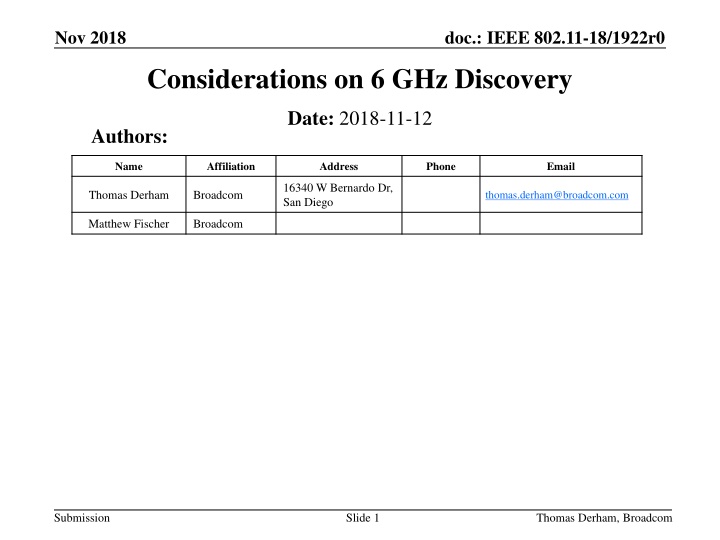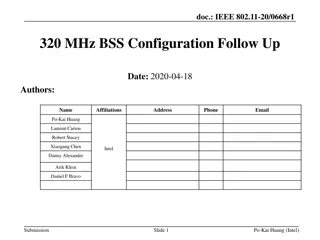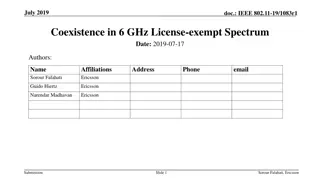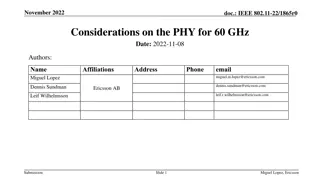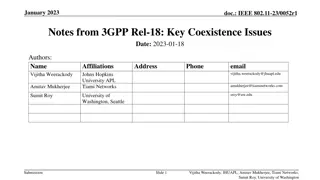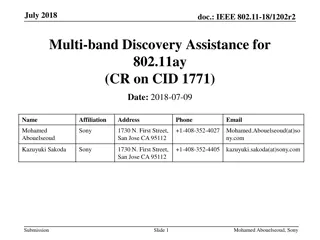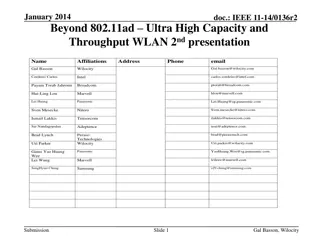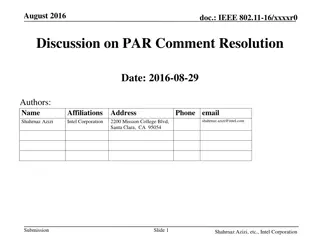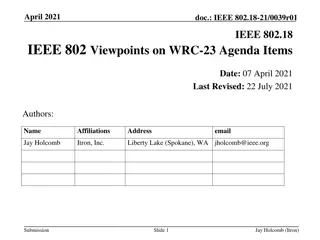Considerations on 6 GHz Discovery for IEEE 802.11-18/1922r0
IEEE 802.11-18/1922r0 document discusses the background and regulatory context for supporting 6 GHz operation in 802.11ax networks. It focuses on optimizing the discovery process for 6 GHz channels to enhance STA and network KPIs. The typical scanning/discovery procedure for non-AP STAs is outlined, highlighting the importance of efficient channel selection and assessment criteria for BSS association. As regulatory proceedings continue for unlicensed 6 GHz spectrum use, quick and effective discovery methods are essential for future network deployments.
Download Presentation

Please find below an Image/Link to download the presentation.
The content on the website is provided AS IS for your information and personal use only. It may not be sold, licensed, or shared on other websites without obtaining consent from the author.If you encounter any issues during the download, it is possible that the publisher has removed the file from their server.
You are allowed to download the files provided on this website for personal or commercial use, subject to the condition that they are used lawfully. All files are the property of their respective owners.
The content on the website is provided AS IS for your information and personal use only. It may not be sold, licensed, or shared on other websites without obtaining consent from the author.
E N D
Presentation Transcript
Nov 2018 doc.: IEEE 802.11-18/1922r0 Considerations on 6 GHz Discovery Date: 2018-11-12 Authors: Name Affiliation Address Phone Email 16340 W Bernardo Dr, San Diego Thomas Derham Broadcom thomas.derham@broadcom.com Matthew Fischer Broadcom Submission Slide 1 Thomas Derham, Broadcom
Nov 2018 doc.: IEEE 802.11-18/1922r0 Background 802.11ax supports operation in the 6 GHz band. In a typical environment, there will be multiple ESS, each comprising multiple BSS, operating on primary channels spread across the 2.4, 5 and 6 GHz bands The introduction of 6 GHz operation will substantially increase the total number of primary channels on which BSSs might be operating In the general case, a non-AP STA needs to discover (all) these BSS, spread across the multiple bands/channels, and decide which (if any) to associate to, typically based on multiple criteria, e.g. Per-network match on configured profile (e.g. SSID, security AKM/credentials, policy, ...) Per-BSS link quality assessment (e.g. based on RSSI, channel utilization, ...) Objective: Optimize discovery (of 6 GHz channels) per two classes of KPIs: (1) STA KPIs: fast and energy-efficient discovery (e.g. for roaming, network re-selection) despite the increase in total number of channels (2) Network KPIs: minimize impact of discovery on network capacity and latency (e.g. avoid probe storms that degrade capacity and increase collisions) Most all of the necessary building blocks are already present in 802.11 Submission Thomas Derham, Broadcom 2
Nov 2018 doc.: IEEE 802.11-18/1922r0 Regulatory Context Regulatory proceedings towards unlicensed operation in 6 GHz spectrum are ongoing in multiple domains The details of potential regulatory rulings are not yet clear, but it is expected (e.g. see [1]) that client devices (non-AP STAs) will operate under some kind of control by an AP i.e. a chain-of-trust under the assumption that the AP master is operating per regulatory rules It is reasonable to draw a parallel with 5 GHz DFS rules, e.g. a non-AP STA is enabled to transmit on a 6 GHz channel (possibly with certain exceptions) by reception of a signal such as a Beacon frame from an AP on that channel Therefore, it is prudent to ensure that 6 GHz discovery can be performed quickly and efficiently under such rules faster than typical discovery time on 5 GHz DFS channels today while ensuring negligible impact on spectral efficiency [1] https://docs.fcc.gov/public/attachments/FCC-18-147A1.pdf Submission Thomas Derham, Broadcom 3
Nov 2018 doc.: IEEE 802.11-18/1922r0 Typical Scanning/Discovery procedure by non-AP STA (Step 1) Determine a set of channels to be scanned Typically, the set of channels that the STA considers are likely to contain BSSs (of interest) For each channel in the channel set.. (Step 2) Receive information in Beacon / Probe Response from each BSS on the channel evaluate each BSS based on measurements and contents of Beacon / Probe, e.g. SSID (and/or Roaming Consortium, etc) network selection policy RSNE security policy PHY/MAC Capabilities, link quality metrics (RSSI, BSS Load, ESP, ...) link quality VSIEs vendor-specific policies and feature support From all the discovered BSS on all scanned channels... (Step 3) Choose target BSS (if any) and initiate authentication/association procedure Submission Thomas Derham, Broadcom 4
Nov 2018 doc.: IEEE 802.11-18/1922r0 (Step 1) Determine a set of channels to be scanned Although the introduction of 6 GHz increases the number of channels on which BSSs might be operating, in most use cases the STA can substantially prune the set of channels to be scanned based on a-priori information. Examples: Already well covered by 802.11 and WFA certifications, minor tweaks would be beneficial (see next slide) - (a) For roam scan, STA might only / preferentially scan channels on which the serving AP has indicated that neighboring BSS in the same ESS are operating - e.g. STA receives solicited/unsolicited Neighbor Report / BTM Response from serving AP - (b) For scan to establish P2P (Soft-AP) data link, a higher-layer protocol (e.g. service discovery) operating on 2.4 or 5 GHz band will typically negotiate/determine the channel to be used by the Soft-AP Out of scope of 802.11 - (c) For full scan (background / unassociated), STA might dynamically prune channels from the channel set based on information received from other APs during the first part of the scan - e.g. STA discovers basic information about APs operating on 6 GHz channels from Beacons / Probe Responses received during its scan of 2.4 / 5 GHz channels - STA uses this basic information to prune or deprioritize scan of 6 GHz channels that are unlikely to be of interest Propose requirement on AP devices operating in 6 GHz to optimize this use case (see next slide) Submission Thomas Derham, Broadcom 5
Nov 2018 doc.: IEEE 802.11-18/1922r0 (Step 1) Determine a set of channels to be scanned [cont] Requirements to optimize step (1): Mandatory requirement for a 2.4 / 5 GHz AP that is co-located with one or more 6 GHz APs with the same SSID to provide basic information about those 6 GHz APs in 2.4 / 5 GHz band Note it is possible an AP device may be operating multiple BSS on 6 GHz with the same SSID (e.g. on different 6 GHz subbands). Co-located AP means, per baseline, that the AP that shares the same antenna connector as the reporting AP (e.g. REVmd D1.6 9.4.2.21.10) i.e. we can interpret this as being APs operated by the same physical AP device (e.g. dual/tri/quad-band concurrent AP) The basic information to be advertised on 2.4 / 5 GHz band (in decreasing order of importance) 1. OpClass + Channel: STA needs to know the 6 GHz channel on which the BSS is operating, so it does not prune (or prioritizes) scan on that channel 2. (Short) SSID: Allow STA to determine whether it is interested in the BSS s network note: for mandatory signaling of same-SSID co-located AP(s), this equals the SSID of the AP reporting the information note: indication that an AP is co-located with the reporting AP allows RSSI guesstimation (e.g. prune weak RSSIs) 3. TBTT (if known by 2.4 / 5 GHz AP not always): Allow STA to schedule passive scan of Beacon on 6 GHz 4. BSSID: Useful for STA to match a Beacon / Probe Response received on 6 GHz Note: Reduced Neighbor Report is a good example of an existing element in baseline that can efficiently carry this information in 2.4/5 GHz beacons/probes (also a WFA certified feature) Since most 6 GHz APs will be part of dual/tri/quad-band concurrent AP devices, this mandatory requirement is sufficient for STA to discover existence of most 6 GHz APs from 2.4+5 GHz scan 6 GHz APs that are not of this nature will likely have alternative mechanisms to a-priori determine the operating channel (e.g. P2P discovery of Soft AP, industrial network with preconfigured STAs, hidden network, etc) Submission Thomas Derham, Broadcom 6
Nov 2018 doc.: IEEE 802.11-18/1922r0 (Step 2) Receive information in Beacon or Probe Responses from each BSS Once the STA has determined a set of channels containing BSSs (of interest), it then needs to receive information contained in Beacon or Probe Response frames from each BSS In the general case, this requires an on-channel 6 GHz scan for each channel in the set Since no legacy (pre-11ax) devices will be operating on 6 GHz band, optimization of the on- channel scan/discovery procedure can be particularly effective STA KPI: Minimize dwell time (and transmissions) on each 6 GHz channel Network KPI: Minimize airtime overhead consumed by discovery-related frames Submission Thomas Derham, Broadcom 7
Nov 2018 doc.: IEEE 802.11-18/1922r0 (Step 2) Receive information in Beacon or Probe Responses from each BSS [cont] Fast Passive Scan Support for a Fast passive scanning mechanism in 6 GHz is important: If STA has to perform legacy passive scan (blindly listen for Beacon), typical dwell time per channel is > 100 ms Consumes excessive power (esp for battery-powered STAs) Slow roams contribute to outage (even if the number of channels to be scanned is relatively small per Step 1 pruning) Even if rules allow STA to send (certain types of) probe requests, existence of a Fast passive scan mechanism minimizes cases where it is desirable to do so, and so helps minimize probe airtime overhead Mandatory so STA can discover all BSS on 6 GHz channel with ~15-20 ms dwell time (similar to active scan, same/better discovery probability as passive scan with 100+ ms dwell time) FILS DF can also be used as enablement signals Requirements to support Fast Passive Scan An HE AP operating on a 6 GHz primary channel transmits (11ai) FILS Discovery Frames at a regular cadence (e.g. 15-20 TUs) Includes Short SSID and TBTT information (and BSSID = TA) For Multi BSSID case, just Transmitted BSSID sends FILS DF, containing RNR to indicate the Short SSIDs of non-transmitted BSSIDs (which STA might be interested in) Allows STA to determine if BSS is of interest or not, and therefore whether to schedule reception of Beacon at TBTT. (STA might go to sleep, return to home channel, or schedule dwell on another channel, while waiting for TBTT) An HE AP operating on a 6 GHz primary channel always uses Multiple BSSID element if it is operating multiple BSSs (VAPs) Mandatory feature to support in 11ax, in 6 GHz it is guaranteed that all STAs can parse it avoid Beacon/Probe overhead multiplication from VAPs Submission Thomas Derham, Broadcom 8
Nov 2018 (Step 2) Receive information in Beacon or Probe Responses from each BSS [cont] doc.: IEEE 802.11-18/1922r0 Fast Passive Scan [cont] Analysis of total Fast Passive scan airtime overhead assumptions: 1x Beacon + 4x FILS Discovery frame per 100 TU TBTT, per AP device Transmitted in HE SU PPDU at a low mandatory HE rate of 8.6 Mbps (0.8 us GI, LTF=2) Durations: Preamble: 54.4 us Beacon payload (~250 bytes): 232.8 us FILS Discovery Frame payload (48 bytes): 44.7 us Beacon frame: 287.2 us => airtime per AP device = 287.2 * (1000/102.4) us/sec => 0.28% FILS Discovery frames (in standalone PPDU): 99.1 us => airtime per AP device = 99.1*4 * (1000/102.4) us/sec => 0.39% Note: If AP is anyway transmitting Trigger frames at the same cadence, FILS Discovery Frame overhead could be further reduced by aggregation in the same PPDU => 0.17% These are very small overheads to enable efficient passive discovery in 6 GHz Submission Thomas Derham, Broadcom 9
Nov 2018 (Step 2) Receive information in Beacon or Probe Responses from each BSS [cont] Example: doc.: IEEE 802.11-18/1922r0 Fast Passive Scan [cont] 20 TUs Beacon 20 MHz AP1 FILS AP2 Discovery Frame Sleep, return to home channel, dwell on another channel, etc TBTT listen end TBTT listen start Dwell end Dwell start STA Discover AP1 Short-SSID of interest so schedule listen at TBTT Discover AP2 Short-SSID not of interest so ignore Dwell finished in ~20 ms Submission Thomas Derham, Broadcom 10
Nov 2018 (Step 2) Receive information in Beacon or Probe Responses from each BSS [cont] doc.: IEEE 802.11-18/1922r0 Active Scan Active scan (transmission of probe requests) is primarily important for roam scan: STA needs to scan several channels containing roam candidate BSS, receive a beacon/probe from each BSS (to check capabilities, assess link quality, etc), and initiate association to the target BSS quickly before connectivity with current serving AP is lost Comparative example: STA does purely passive scan on reception of a Neighbor Report from serving AP, which indicates roam candidates on five different 6 GHz channels Fast passive scan with 20 ms dwell on each channel On average, STA receives a beacon on 1 channel, and FILS DF on the other 4 channels TBTTs of the other 4 channels are randomly spread, occasionally occur at almost same time on multiple channels Even with optimal scheduling of TBTT listens, total delay to obtain all 5 beacons is likely ~200 ms In contrast, active scan would allow reception of Probe Responses from all channels in <<100 ms Define rules that allow active scan where necessary, without causing unacceptable impact on network capacity or latency In non-time-critical scenarios, STAs would primarily use the Fast passive scan mechanism Submission Thomas Derham, Broadcom 11
Nov 2018 (Step 2) Receive information in Beacon or Probe Responses from each BSS [cont] doc.: IEEE 802.11-18/1922r0 Active Scan [cont] Avoids retransmit overhead, e.g. if STA moves out of coverage or finishes dwell before response sent. Also allows other STAs that are concurrently listening to also hear the probe response Requirements to support (limited) Active Scan An HE AP operating on a 6 GHz primary channel, when responding with a Probe Response frame to a Probe Request frame sent to the broadcast address, sends the Probe Response frame to the broadcast address in a 20 MHz SU PPDU Simple reference to this rule introduced by 11ai Wildcard-SSID probe requests result in multiplicative overhead (solicit probe responses from every AP) so must be minimized prime cause of probe storms. Directed-SSID probe requests (even with bcast MAC) should be allowed for roam scan If an HE STA performs active scan on a 6 GHz channel: Restrict or disallow transmission of Probe Requests with wildcard SSID The STA shall not transmit more than one Probe Request frame to the broadcast address in an SU PPDU in a given 20 TU period This rule avoids STAs performing an inefficient full (all SSIDs) scan by sending multiple directed probe requests to each SSID. Submission Thomas Derham, Broadcom 12
Nov 2018 (Step 2) Receive information in Beacon or Probe Responses from each BSS [cont] Example: Fast active roam scan doc.: IEEE 802.11-18/1922r0 Active Scan [cont] 20 TUs Beacon 20 MHz AP1 Probe response to bcast address in 20 MHz SU (others STAs can also hear) FILS Discovery Frame AP2 Note: If STA wants to scan for other SSIDs, it does so passively (extends dwell) since it has already sent an SU probe in the 20 ms period Scan start Scan end STA SU Probe request (directed SSID) Probes from both APs received in <20 ms Submission Thomas Derham, Broadcom 13
Nov 2018 doc.: IEEE 802.11-18/1922r0 Summary Given that 6 GHz increases the number of possible primary channels, help optimize STA s scan by ensuring basic information about most 6 GHz APs can be discovered from 2.4 / 5 GHz scan Reuse existing frame such as RNR element from baseline with small enhancements to indicate co-location, non-transmitted BSSIDs, minimize element size, etc Greenfield 6 GHz allows to substantially reduce discovery airtime overhead by mandating the use of a small number of baseline/11ax features: Multiple BSSID (amortize VAPs into single beacon/probe) FILS Discovery frames (fast passive scan) Broadcast probe response (avoid retry overhead) Ensure the probe storm issues are solved, but also make sure roam scans are efficient Simple restricted rules for certain types of probe request transmission Client STAs in 6 GHz will be performing various latency-sensitive operations: do not restrict STA behavior except where a negative impact on network KPIs is clearly evident e.g. roam scan probing, auth/assoc exchanges, ANQP, <<10 ms latency gaming/AR/VR/voice data traffic wildcard-SSID probe requests are a special case because they can solicit a large number of responses for post-association data traffic, ensure flexibility to configure EDCA operation on a per-AC basis optimize service KPIs and network efficiency for each traffic type (e.g. latency-sensitive data vs bulk data) Submission Thomas Derham, Broadcom 14
